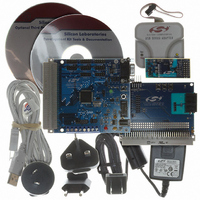MODEMDK Silicon Laboratories Inc, MODEMDK Datasheet - Page 24

MODEMDK
Manufacturer Part Number
MODEMDK
Description
KIT DEV EMBEDDED MODEM
Manufacturer
Silicon Laboratories Inc
Type
Network Controller & Processorr
Datasheet
1.MODEMDK.pdf
(28 pages)
Specifications of MODEMDK
Main Purpose
*
Embedded
*
Utilized Ic / Part
C8051F120
Primary Attributes
*
Secondary Attributes
*
Interface Type
RS-232, RJ-11, JTAG
Product
Modules
For Use With/related Products
C8051F120
Lead Free Status / RoHS Status
Contains lead / RoHS non-compliant
Lead Free Status / RoHS Status
Lead free / RoHS Compliant, Contains lead / RoHS non-compliant
Other names
336-1285
MODEM-DK
A
W
Link/Physical Layer:
SLIP (Serial Line Internet Protocol)—SLIP is a simple
protocol for sending TCP/IP packages along a serial
line. It provides no error-correction and requires that the
device on each end of the connection know the identity
of the device on the other end. SLIP is typically used on
low noise RS232 links between two fixed processors.
PPP (Point to Point Protocol)—PPP is a more robust
protocol for sending TCP/IP packages serially. PPP
provides error correction and provides multiple options
for configuring and connecting across a line. PPP is
commonly used to send TCP/IP packages across
modem lines.
PAP (Password Authentication Protocol)—PAP is a
sub-protocol of PPP which requires that the device
establishing the PPP connection supply a valid
username and password.
Internet Layer:
IP (Internet Protocol)—IP specifies the format of
packets and manages the addressing of all devices on
the network. IP is included in all builds of the TCP/IP
stack.
PING (Packet Internet Groper)—PING is a basic
network program which verifies that a particular IP
address exists and can respond to requests. PING is
included in all builds of the TCP/IP stack.
ARP (Address Resolution Protocol)—ARP converts
higher-level
addresses. It is not available with SLIP or PPP.
Transport Layer:
TCP (Transmission Control Protocol)—TCP is a
connection-oriented transport protocol. It offers a
reliable, full-duplex data stream that may be written to
and read from by devices on the network.
UDP
connectionless, unreliable transport protocol. It formats
data into units called datagrams and sends them across
the network; however, it provides no guarantee that the
data will arrive or that it will be error-free.
Application Layer:
FTP (File Transfer Protocol)—FTP transfers a
complete file from one network device to another. FTP
requires the TCP transport layer. The FTP module in the
TCP/IP stack configures the device to operate as an
FTP server only. It cannot act as an FTP client.
24
PPENDIX
IZARD
(User
IP
Datagram
A—P
addresses
ROTOCOLS
Protocol)—UDP
to
lower-level
S
UPPORTED BY THE
is
MAC
Rev. 0.2
a
HTTP (HyperText Transfer Protocol)—HTTP sends
and requests files (typically HTML files) across a
network. It is commonly used to transfer files across the
World Wide Web. HTTP requires the TCP transport
layer. The HTTP module in the TCP/IP stack configures
the device to operate as an HTTP server only. It cannot
act as an HTTP client or browser.
SMTP (Simple Mail Transfer Protocol)—SMTP sends
and receives e-mails. It requires the TCP transport
layer. The SMTP module in the TCP/IP stack can only
act as an SMTP client. An SMTP server must be
available on the network to forward emails from the
MODEM-DK to the specified e-mail address.
TFTP (Trivial File Transfer Protocol)—TFTP is a
simplified version of FTP. It requires the UDP transport
layer. The TFTP module in the TCP/IP stack can only
act as a TFTP client. It cannot act as a TFTP server.
TCP/IP C
ONFIGURATION












